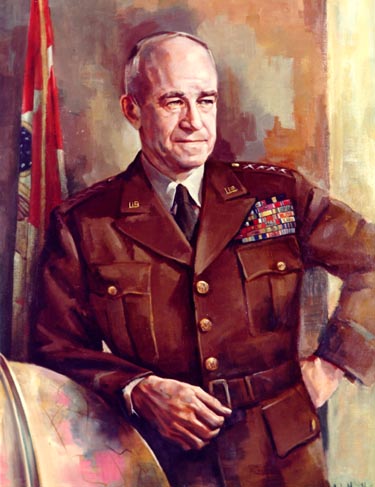By Clarence Lamont MacNelly
Oil on canvas, 38
Omar Nelson Bradley was born in Clark, Missouri, on 12 February 1893; graduated from the United States Military Academy, 1915, was commissioned a second lieutenant, and assigned to the 14th Infantry, June 1915; married Mary Quayle, 1916 (deceased 1965); performed troop duty in the West, 19151919; was promoted to first lieutenant, July 1916, to captain, May 1917, and to temporary major, June 1918; was on Reserve Officer Training Corps duty in Minnesota and South Dakota, 19191920; was instructor in mathematics at West Point, 19201924; reverted to grade of captain, 1920 and 1922, and was returned to major, 1922 and 1924; graduated from the advanced course at the Infantry School at Fort Benning, 1925; served in Hawaii with both the 19th and 27th Infantry, 19251927, and was in charge of National Guard and Reserve affairs for the Hawaiian Islands, 19271928; graduated from the Command and General Staff School at Fort Leavenworth, 1929; was instructor in tactics and weapons at the Infantry School, 19291933; graduated from the Army War College, 1934; was instructor in tactics and plans and training officer at the United States Military Academy, 19341938; was promoted to lieutenant colonel, June 1936; was chief of the Operations Branch, G1, War Department headquarters, 19381940; was assistant secretary of the General Staff, 19401941; was promoted to temporary brigadier general, February 1941; was commandant of the Infantry School and set up the Infantry Officer Candidate Program, 19411942; was promoted to the temporary ranks of major general, February 1942, and lieutenant general, June 1943; successively commanded the 82d and 28th Infantry Divisions, 19421943; was personal representative in the field for the commander of the North African Theater of Operations, 1943; commanded II Corps in operations against Axis forces in North Africa and Sicily, 1943; was promoted to permanent ranks of brigadier general, September 1943, and major general, September 1944; commanded the First Army and the 12th Army Group in the invasion and final campaigns of Western Europe, 19441945; was promoted to temporary general, March 1945, a rank and date made permanent in January 1949; was administrator of veterans affairs, 19451947; was chief of staff of the United States Army, 7 February 194816 August 1949; responded to the National Security Act of 1947 by initiating a study of Army organization that led to appointment of a vice chief of staff and two deputies and to consolidation of technical services under the director of logistics, administrative services under the director of personnel and administration, and financial and management functions under the comptroller of the Army; was the first chairman of the Joint Chiefs of Staff, 16 August 194916 August 1953; was promoted to General of the Army, September 1950; was first chairman of the Military Staff Committee of the North Atlantic Treaty Organization, 19491950; married Esther Dora Buhler, 1966; while attending an Army Association meeting in New York City, died on 8 April 1981.
The Artist
Clarence Lamont MacNelly (19201986) came to art and portraiture in middle life after successful careers in several other lines of endeavor. A graduate of Rutgers University with a degree in economics, he saw World War II service as a Navy officer and then became a senior executive and creative director of a Madison Avenue advertising agency, as well as a magazine publisher. He was in his forties when he turned to art and the study of portraiture under Austrian-born Frederic Taubesinstructor at Cooper Union School, lecturer at the Art Students League, and author of numerous works on art subjects. Taubes considered MacNelly a born portrait painter.
Omar Nelson Bradley
By Clarence Lamont MacNelly
Oil on canvas, 38![]() "
x 28
"
x 28![]() ",
1972
",
1972
[124]

[125]